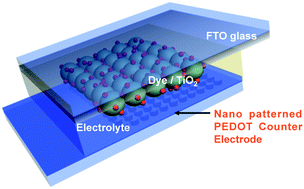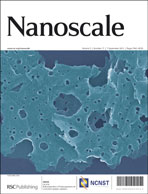A low-cost nanopatterned highly conductive poly(3,4-ethylenedioxythiophene) (PEDOT) thin film was fabricated on a flexible plastic substrate via a chemical polymerization method combined with a nanoimprinting technique and used as a platinum (Pt), TCO-free counter electrode for dye-sensitized solar cells (DSSCs). The catalytic properties of the nanopatterned PEDOT as the counter electrode in DSSCs were studied using cyclic voltammetry, J–V measurements, impedance spectroscopy, and finite-difference time-domain (FDTD) simulations. The nanopatterned PEDOT counter electrodes exhibit better functionality as a counter electrode for tri-iodide reduction when compared to non-patterned PEDOT-based counter electrodes. The Pt and TCO-free DSSCs with a nanopatterned PEDOT-based counter electrode exhibited a power conversion efficiency of 7.1% under one sunlight illumination (100 mW cm−2), which is comparable to that of conventional DSSCs with standard platinum Pt/FTO paired counter electrodes. The ability to modulate catalytic functionality with changes in nanoscale morphology represents a promising route for developing new counter electrodes of Pt and TCO-free DSSCs.

You have access to this article
 Please wait while we load your content...
Something went wrong. Try again?
Please wait while we load your content...
Something went wrong. Try again?


 Please wait while we load your content...
Please wait while we load your content...